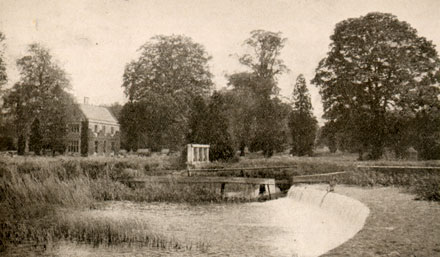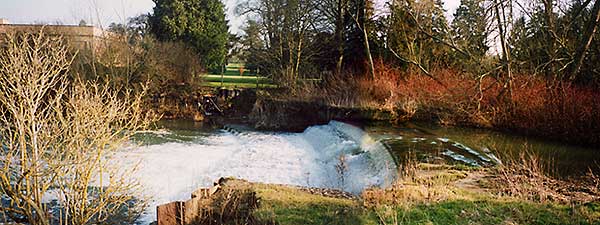|
The Dam
|
||
 The "Waterfall" c. 1900, converted into a dam for the hydro electric scheme. Photo - November 1992 |
||
 1920s photo of the dam - taken from the north side of the river. Note the white wooden structure in the centre. This is the paddle gear that controlled the flow of water down the leat. |
||
| Extract from 'OUSE’S SILENT TIDE' by C.F. Farrar published in 1921 by the Sidney Press, Bedford.
...And now we are skirting what should have been a forest of magnificent trees upon the right bank, which our map tells us is the estate of Thornton Hall, but something has gone wrong with the forest, for it is somehow turned into a marsh, and many once splendid trees stand, gaunt and dead, their roots evidently chilled by the cold water. Here lies prone in the stream a magnificent chestnut tree, uprooted by some flood of last winter through the water loosening the soil at its roots, and yet it has made one last effort for life, and, has thrown out a final crop of full leaf and beautiful white chestnut blossoms. I suppose by next spring it will lie a gaunt, dreary spectre of itself dead. And then suddenly on the right bank we come to a stately mansion, Thornton Hall. The place, so my County History tells me, was once the seat of lordly families who kept baronial state there in the past, but I am not writing of such matters. And then I discovered the secret of that dying forest above; for some selfish person in the past had dammed the river from bank to bank with a great brick barrier over which the river trickles down a drop of 5 to 10 feet. Very picturesque to see, no doubt, from the drawing-room of Thornton Hall, but an act of sheer, wanton selfishness. We are presently to see the destructive nature of this barrier by the wreckage of the river for some miles below. Of course, when the floods come in winter the upper river pours over the barrage with frightful force. If I may offer a suggestion to the Ouse Drainage Board which is to be formed, I would advise them to visit this spot where they will find some useful work to do in removing this picturesque but destructive barrier. But there seems something uncanny about Thornton Hall; three fair damsels are playing ball, like the maidens of Nausicaa on the lawn but at the first glimpse of us, novel as must the sight of a boat have been to them, they turn and fly and presently the side door opens and a nun emerges, who, without a glance at us, paces up and down the walk between us and the Hall like an agitated hen. We have come upon a nunnery, and it is half-past twelve, and we have disturbed the recreation hour of the novices, and lest they brake the “Rule of the Eye” their recreation hour has been suddenly cut short, and they have been banished to their cells, for fear the rude male eye of two such ancient buffers as the Colonel and myself, to say nothing of C.B., should rest upon them. Though the ecclesiastical sentry continued her agitated beat, we took a photograph of that barrier for the possible use and information of the Ouse Drainage Board, and then we hastened away in time, I hope, for the novices to resume their game of ball before the bell rang for some “Hour” or for lunch... Mr Farrar and his son and Colonel Young travelled down the River Ouse from Brackley to Bedford in 1920. He opposed the Drainage Board which took over from the 97 local authorities which looked after the river. Photos of the party’s journey were taken by his son C B Farrar. |
||
 This shows work undertaken by the Drainage Board in the late 1960s/70 where they filled in the sluices and adjusted the length of the trough in the middle and used sheet piling to reinforce the banks. On the opposite bank there can just be seen a brick built drain that takes rain water from Thornton village diches and drains through the grounds and under the lawns. |
||